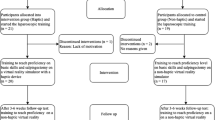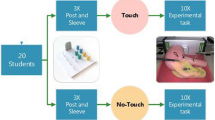Abstract
Background
Virtual reality (VR) simulation for laparoscopic training is available with and without haptic feedback features. Currently, there is limited data on haptic feedback’s effect on skill development. Our objective is to compare expert laparoscopists’ skills characteristics using VR delivered laparoscopic tasks via haptic and nonhaptic laparoscopic surgical interfaces.
Methods
Five expert laparoscopists performed seven skills tasks on two laparoscopic simulators, one with and one without haptic features. Tasks consisted of 2-handed instrument navigation, retraction and exposure, cutting, electrosurgery, and complicated object positioning. Laparoscopists alternated platforms at default difficulty settings. Metrics included time, economy of movement, completed task elements, and errors. Progressive change in performance for the final three iterations were determined by repeated measures ANOVA. Iteration quartile means were determined and compared using paired t-tests.
Results
No change in performance was noted in the last three iterations for any metric. There were no significant differences between platforms on the final two quartiles for most metrics except avoidance of over-stretch error for retraction; and cutting task was significantly better with haptics on all iteration quartiles (p < 0.03). Economy of movement was significantly better with haptics for both hands for clip application (p < 0.01) and better for right hand on complex object positioning (p < 0.05). Accuracy was better with haptics for retraction and cutting (p < 0.05) and clip application (p < 0.05).
Conclusion
Results showed higher performance in accuracy, efficient instrument motion, and avoidance of excessive traction force on selected tasks performed on VR simulator with haptic feedback compared to those performed without haptics feedback. Laparoscopic surgeons interpreted machine-generated haptic cues appropriately and resulted in better performance with VR task requirements. However, our results do not demonstrate an advantage in skills acquisition, which requires additional study.
Graphical abstract





Similar content being viewed by others
References
Satava RM (1993) Virtual reality surgical simulator: the first steps. Surg Endosc 7:203–205
Coles TR, Meglan D, John NW (2011) The role of haptics in medical training simulators: a survey of the state of the art. IEEE Trans Haptics 4(1):51–66. https://doi.org/10.1109/TOH.2010.19
Gurusamy K, Aggarwal R, Palanivelu L, Davidson BR (2008) Systematic review of randomized controlled trials on the effectiveness of virtual reality training for laparoscopic surgery. Br J Surg 95(9):1088–1097. https://doi.org/10.1002/bjs.6344
Våpenstad C, Hofstad EF, Bø LE, Kuhry E, Johnson G, Marvik R, Lange T, Hernes TN (2017) Lack of transfer of skills after virtual reality simulator training with haptic feedback. Minim Invasive Ther Allied Technol 26(6):346–354. https://doi.org/10.1080/13645706.2017.1319866
Thompson JR, Leonard AC, Doarn CR, Roesch MJ, Broderick TJ (2011) Limited value of haptics in virtual reality laparoscopic cholecystectomy training. Surg Endosc 25(4):1107–1114. https://doi.org/10.1007/s00464-010-1325-2
Zhou M, Tse S, Derevianko A, Jones DB, Schwaitzberg SD, Cao CG (2012) Effect of haptic feedback in laparoscopic surgery skill acquisition. Surg Endosc 26(4):1128–1134. https://doi.org/10.1007/s00464-011-2011-8
Botden SMBI, Buzink SN, Schijven MP, Jakimowicz JJ (2007) Augmented versus virtual reality laparoscopic simulation: what is the difference? A comparison of the ProMIS augmented reality laparoscopic simulator versus LapSim virtual reality laparoscopic simulator. World J Surg 31(4):764–772. https://doi.org/10.1007/s00268-006-0724-y
Guedes HG, Câmara Costa Ferreira ZM, Ribeiro de Sousa Leão L, Souza Montero EF, Otoch JP, Artifon ELA (2019) Virtual reality simulator versus box-trainer to teach minimally invasive procedures: a meta-analysis. Int J Surg 61:60–68. https://doi.org/10.1016/j.ijsu.2018.12.001
Ko JKY, Cheung VYT, Pun TC, Tung WK (2018) A randomized controlled trial comparing trainee-directed virtual reality simulation training and box trainer on the acquisition of laparoscopic suturing skills. J Obstet Gynaecol Can 40(3):310–316. https://doi.org/10.1016/j.jogc.2017.07.010
Salkini MW, Doarn CR, Kiehl N, Broderick TJ, Donovan JF, Gaitonde K (2010) The role of haptic feedback in laparoscopic training using the LapMentor II. J Endourol 24(1):99–102. https://doi.org/10.1089/end.2009.0307
Våpenstad C, Hofstad EF, Langø T, Mårvik R, Chmarra MK (2013) Perceiving haptic feedback in virtual reality simulators. Surg Endosc 27(7):2391–2397
Overtoom EM, Horeman T, Jansen FW, Dankelman J, Schreuder HWR (2019) Haptic feedback, force feedback, and force-sensing in simulation training for laparoscopy: a systematic overview. J Surg Educ 76(1):242–261. https://doi.org/10.1016/j.jsurg.2018.06.008
Huber T, Paschold M, Hansen C, Wunderling T, Lang H, Kneist W (2017) New dimensions in surgical training: immersive virtual reality laparoscopic simulation exhilarates surgical staff. Surg Endosc 31(11):4472–4477. https://doi.org/10.1007/s00464-017-5500-6
Horeman T, Rodrigues SP, van den Dobbelsteen JJ, Jansen FW, Dankelman J (2012) Visual force feedback in laparoscopic training. Surg Endosc 26(1):242–248. https://doi.org/10.1007/s00464-011-1861-4
Rangarajan K, Davis H, Pucher PH (2020) Systematic review of virtual haptics in surgical simulation: a valid educational tool? J Surg Educ 77(2):337–347. https://doi.org/10.1016/j.jsurg.2019.09.006
Funding
None.
Author information
Authors and Affiliations
Corresponding author
Ethics declarations
Disclosures
Dr. Margaret Siu, Dr. Kaitlin Debbink, Amanda Duda, Dr. George Orthopoulos, Dr. John Romanelli, Dr. Jacqueline Wu, and Dr. Neal E. Seymour have no conflicts of interest or financial ties to disclosure. This research did not receive any specific grant from funding agencies in the public, commercial, or not-for-profit sectors.
Additional information
Publisher's Note
Springer Nature remains neutral with regard to jurisdictional claims in published maps and institutional affiliations.
This research was presented at the SAGES 2023 Annual Meeting on March 30, 2023 in Montreal, Canada, as an oral presentation for the Education Quickshot Session; program S145.
Rights and permissions
Springer Nature or its licensor (e.g. a society or other partner) holds exclusive rights to this article under a publishing agreement with the author(s) or other rightsholder(s); author self-archiving of the accepted manuscript version of this article is solely governed by the terms of such publishing agreement and applicable law.
About this article
Cite this article
Siu, M., Debbink, K., Duda, A. et al. Expert laparoscopist performance on virtual reality simulation tasks with and without haptic features. Surg Endosc 37, 8748–8754 (2023). https://doi.org/10.1007/s00464-023-10321-5
Received:
Accepted:
Published:
Issue Date:
DOI: https://doi.org/10.1007/s00464-023-10321-5




